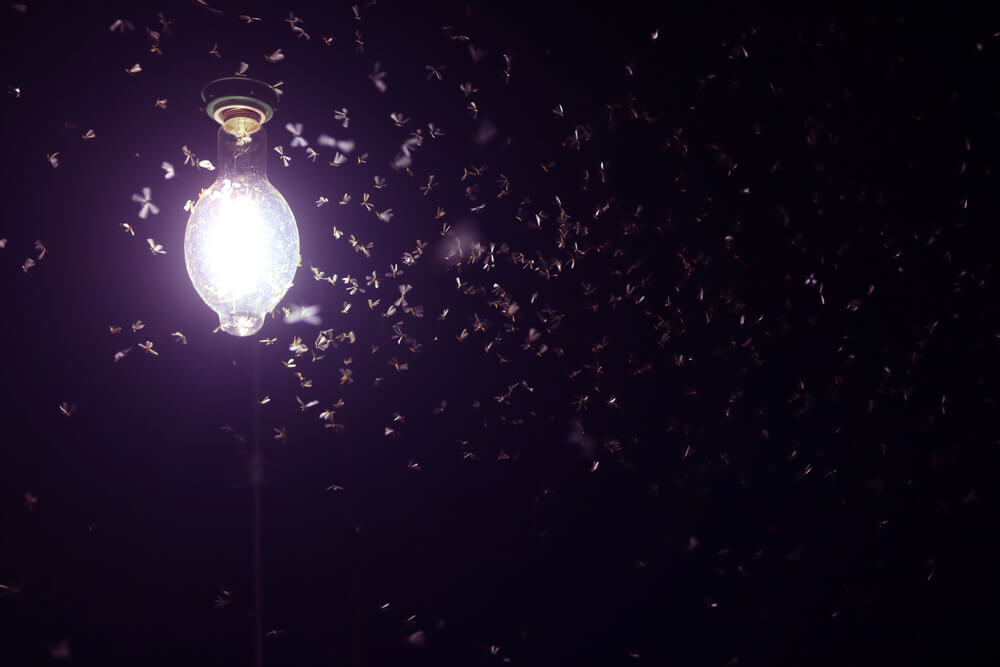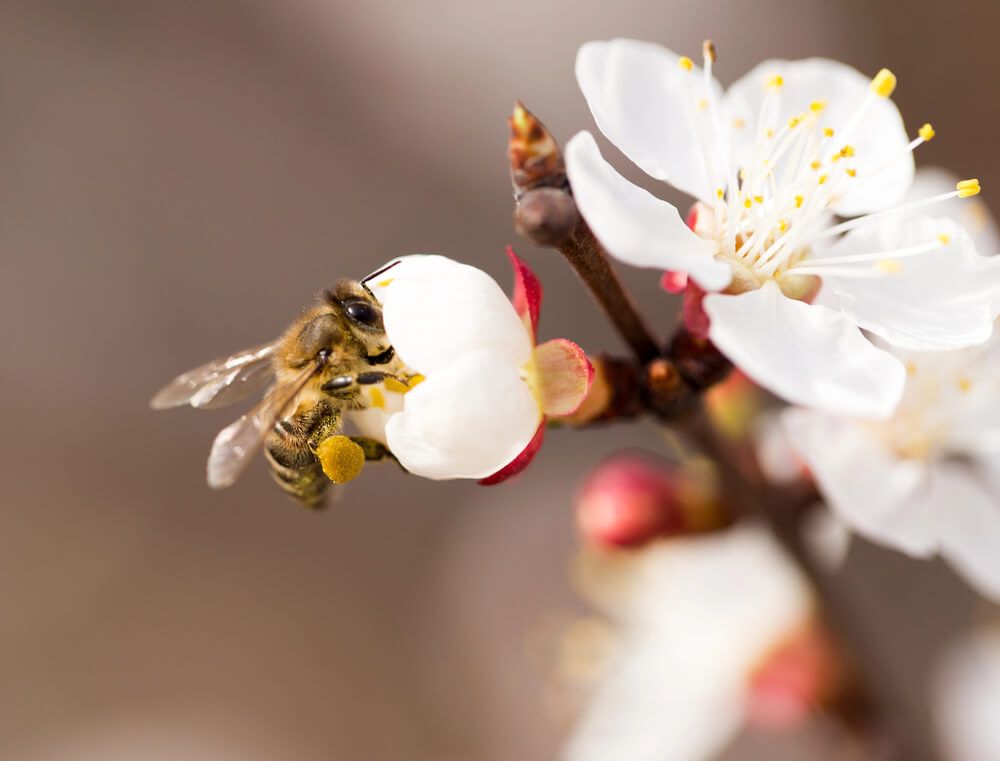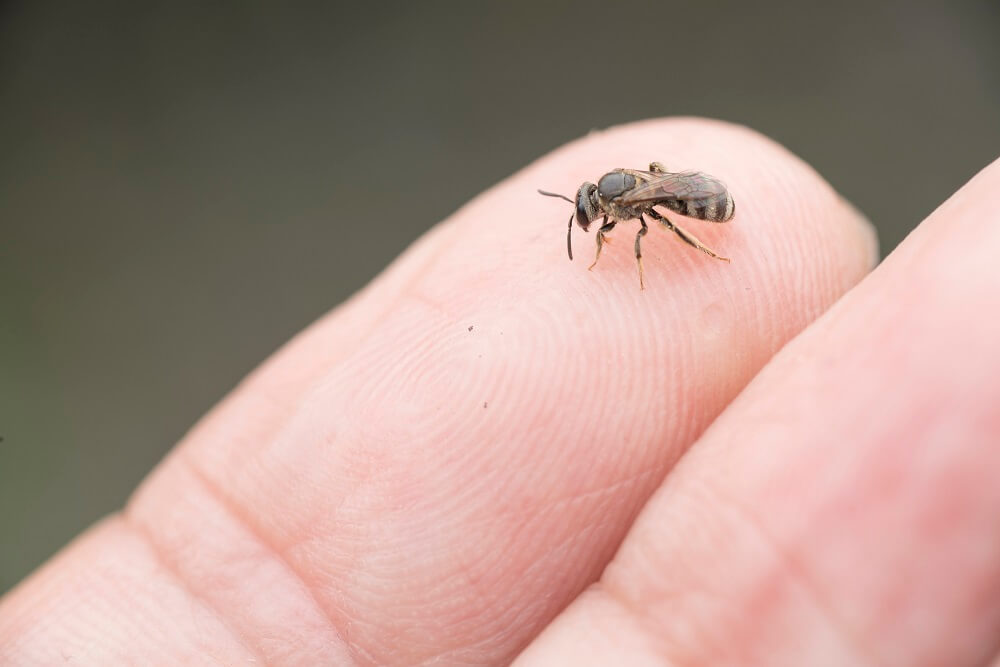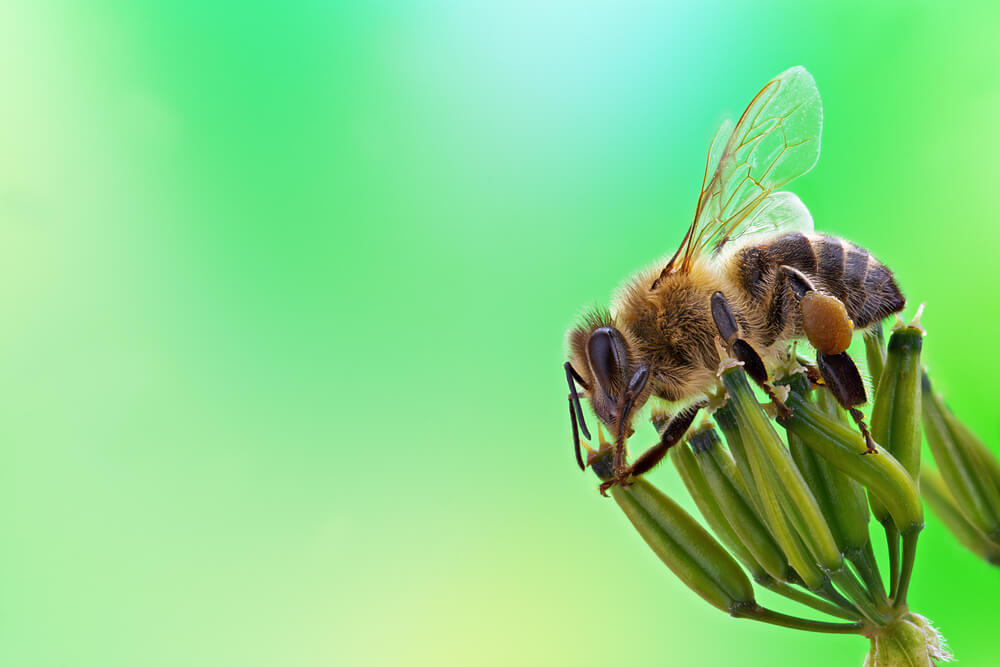Table of Contents:
Are Bees Attracted to Light?
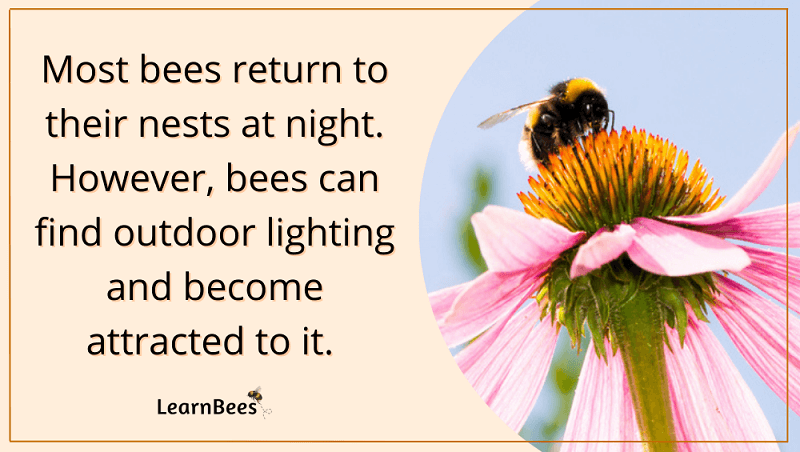
Like many insects, bees can be attracted to light.
A bee’s attraction to light is known as positive phototaxis. Positive phototaxis occurs when an organism is drawn toward light, while negative phototaxis occurs when an organism is drawn away from light.(1, 2)
For example:
Cockroaches are known for having negative phototaxis. This explains why they scatter when a light is flicked on. In contrast, moths have positive phototaxis because they’re fixated on lights.(2)
Bees are more likely to become attracted to lights during the summer on really warm nights.
Keep in mind:
Bees are hardworking little creatures that stay busy during the warm months.
They often work from sun up to sun down, seven days per week, with no vacation days. Bees quite literally work themselves to death.
That’s why it’s not uncommon to see dead bees around flowers. They were foraging for nectar until their final moment.
More importantly?
Bees use sunlight as an alarm clock and for help with navigation.
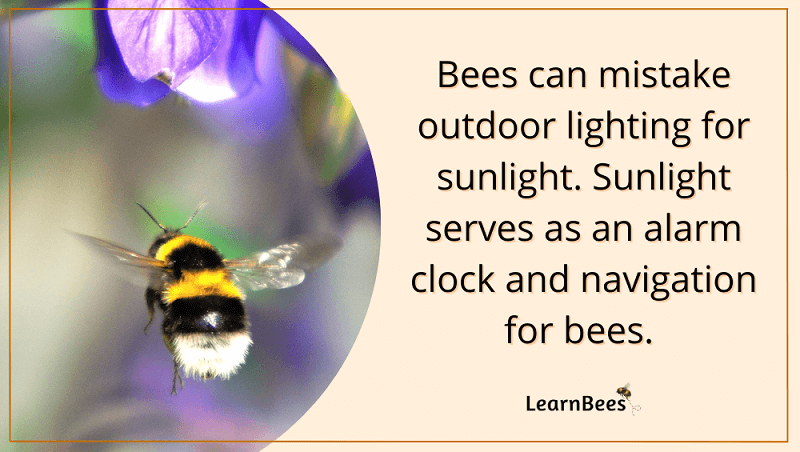
Sunlight is essentially their wake-up call to go to work. As such, bees sometimes mistake outdoor lights for sunlight and think it’s time to go forage on flowers.
Now you may be wondering how to get rid of bees attracted to light.
The answer is simple:
Turn off the light source and use motion-sensor lights instead. Additionally, you can also replace your bulbs with yellow LED bulbs.
Why is this important?
Because outdoor lights are ecological deathtraps for beneficial insects like bees, moths, and ladybugs. For most insects, a trip to an outdoor light is a one-way trip. They’ll often fly around the light for hours until they exhaust themselves and die. Or, they’ll get eaten by bats, frogs, or other animals.(3, 4)
Not good.
We rely on bees and other insects for pollination. Without them, our food supply would be in trouble.
Can Bees Die From a Light Bulb?
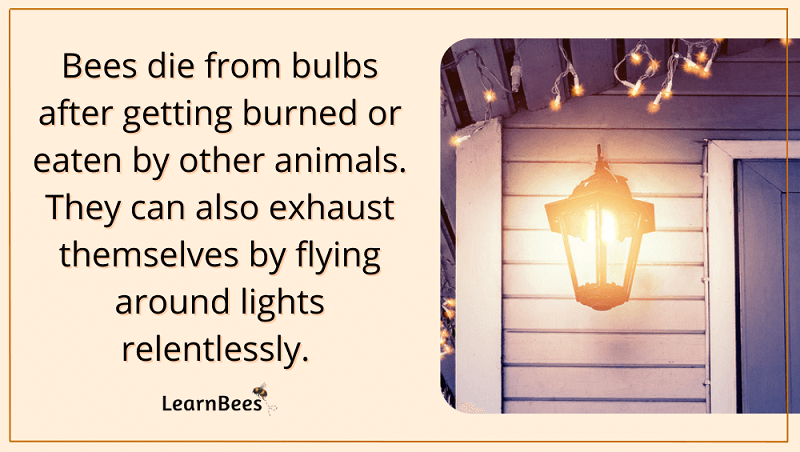
Bees die from light bulbs because they’ll either exhaust themselves by flying around them or they’ll get eaten by other animals.
For instance, it’s not unusual to see frogs hanging around your porch if you leave outdoor lighting on. These frogs prey on insects that are drawn to porch lighting.(4, 5)
The best solution for deterring bees is to cut off the lights.
We recommend installing motion-sensor lighting instead. Motion-sensor solar lights are also popular for lighting around fences, sheds, or yards.
Additionally:
Switch all your outdoor bulbs to yellow LEDs.
LEDs are an energy-efficient alternative that’s at least 75% more efficient than a traditional light bulb. LEDs are also long-lasting, which is another money-saving bonus.(6)
Are Bees Attracted to Blue Light?
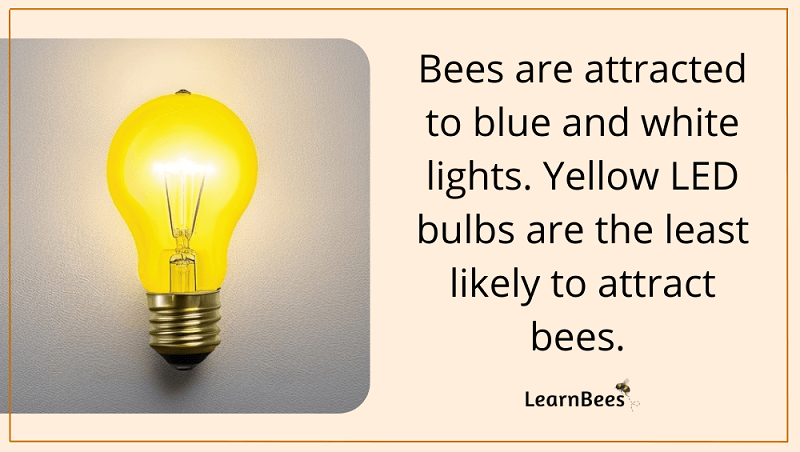
Blue lights and white lights are the most attractive to bees. Yellow, red, or orange LEDs are the least attractive to bees.
Why are bees attracted to light?
A few reasons:
- Lights confuse the bee’s internal navigation: Bees and many other creatures use light to navigate. This is why; if you’ve ever been to the Florida keys, you’ll notice the streetlights are red. It keeps the baby sea turtles from confusing the street lights with the moonlight and getting lost. To animals and insects, both the moonlight and sunlight help them find their way.
- Lights serve as an alarm clock for bees. Most bee species are diurnal creatures that are active during the day. As the sun rises, the forager bees begin stirring to pollinate flowers. However, outdoor lights can confuse bees by making them think it’s daylight. They’ll fly around the lights tirelessly until they die from exhaustion or get eaten.
- Lights are warm: Traditional light bulbs emit a lot of heat which is attractive to bees and other insects. For example, bees are most active during the warm months. Summer is considered “prime time” for them.
You can save bees and other beneficial insects by simply turning off your outdoor lighting.
For safety, you can install motion-sensor lighting where you need it.
For example, I installed motion-sensor solar lighting near my garage, front porch, and back porch. It was a quick, cost-effective solution that didn’t require an electrician’s help.
When you do this, you’re not only helping bees, but you’re also helping other native insects that we rely on.
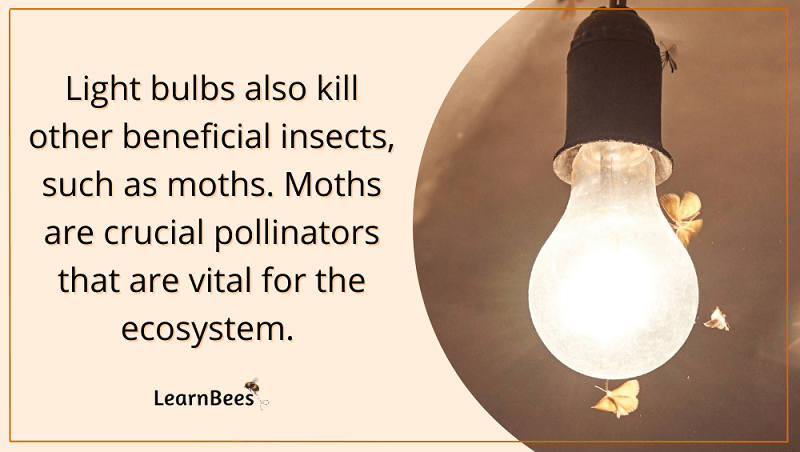
Moths are a great example of this.
Most people realize that moths are drawn to lights like a magnet. However, most people don’t realize that moths play a crucial role in our food webs.(5)
For one, moths are important pollinators that are most active after dark. They fly around pollinating flowers while other insects have settled down for the night.(7)
Pollination directly affects our food supply. We rely on pollinators for apples, cherries, oranges, squash, and even coffee.(8, 9)
Secondly, moths serve as a nutritious food source for birds, mammals, and other insects. Without them, many animals would take a serious hit on their food supply.
FAQs on “Are Bees Attracted to Light?”
- Are large bees attracted to light at night?
- Why do honey bees die after getting attracted to a white light?
- Are bees attracted to bug zappers?
- Do LED lights attract bees?
- Why do bees fly around my light?
- What type of bee is attracted to light?
- What color light do bees hate?
- What time of night do bees go away?
- Do bees do anything at night?
Are large bees attracted to light at night?
Yes, large bees like bumble bees and carpenter bees may be attracted to lights at night. To prevent this, you should avoid using bright lights at night or use yellow LED bulbs instead.
Both bumble bees and carpenter bees are native pollinators, and their presence benefits your local ecosystem. They’re beneficial to local farmers and can directly affect your food supply.
To help protect them, it’s best to use motion-activated lighting near your home or porch areas instead of keeping a bright light on all night. Bright lights harm bees and other insects because they can mistake them for sunlight.
Sunlight serves as a navigation for bees and can attract them to outdoor lights. Bees also use sunlight as a wake-up call to venture outside the nest to collect nectar from flowers. Outdoor lighting can confuse bees by making them think it’s daytime instead of nighttime.
—> Go back to the FAQs on “Are Bees Attracted to Light?”
More to Explore:
Why do honey bees die after getting attracted to a white light?
Honey bees die after getting attracted to white lights because they’re vulnerable to being eaten by other animals. Bats, frogs, and other creatures will purposely hang around lights to catch bugs that are attracted to them.
Honey bees will also die after getting attracted to white lights because they’ll run ragged while flying around them. They’ll literally exhaust themselves to death while flying around lights until finally, they drop to the ground.
Lastly, white lights that emit a lot of heat can kill bees by “zapping” them. The heat can burn its wings and other body parts if a bee gets too close to a white light.
A bee’s wings are thin and transparent. They can be extremely delicate when paired up against hot outdoor bulbs. If a bee loses a wing, it guarantees the bee will have a shorter life. Flight is a bee’s main method of transportation, so it’s important to have healthy wings.
—> Go back to the FAQs on “Are Bees Attracted to Light?”
More to Explore:
Are bees attracted to bug zappers?
Bees can be attracted to bug zappers. Bees have a positive phototaxis, meaning they’ll fly toward the light. This is especially true regarding bright white or blue lights.
Bug zappers are designed to kill the insects that come close to them. Unfortunately, some bees can get caught in their electric grids and die. This can harm local bee populations, as bees are important pollinators for our food web.
—> Go back to the FAQs on “Are Bees Attracted to Light?”
More to Explore:
Do LED lights attract bees?
LED lights are less likely to attract bees than traditional bulbs. However, this isn’t foolproof, as bees may still be attracted to some LED lights. The best option is to use yellow LED light bulbs. These bulbs produce light that is the least attractive to bees.
However, turning off the lights and using motion-sensor lighting is still the best option. This way, you won’t attract bees and other important insects to your home at night. In turn, you can save these beneficial pollinators from death.
—> Go back to the FAQs on “Are Bees Attracted to Light?”
More to Explore:
Why do bees fly around my light?
Most bees go back to their nest at night. However, sometimes bees can find themselves near outdoor lighting. Like many insects, bees are drawn to lighting because they may mistake it for the sun.
Too much exposure to light can harm bees and other insects, as it can confuse them, tire them out, and even burn their wings. To protect bees from this kind of danger, it’s best to turn off outdoor lights at night or use motion-sensor lighting instead. That way, you won’t be attracting bees to your property unnecessarily.
—> Go back to the FAQs on “Are Bees Attracted to Light?”
More to Explore:
What type of bee is attracted to light?
This is a common question we get, along with the following:
Does light attract bees at night? Do bees gravitate towards light? Are bees attracted to light or dark?
The answer is that all bee species can be attracted to light, including honey bees, bumble bees, carpenter bees, and more.
—> Go back to the FAQs on “Are Bees Attracted to Light?”
More to Explore:
What color light do bees hate?
Bees are least drawn to warm LED lights, like yellow or red. Blue and white lights attract bees the most, so it’s best to avoid these colors when setting up outdoor lighting.
—> Go back to the FAQs on “Are Bees Attracted to Light?”
More to Explore:
- What Are Black and Yellow Wasps?
- How Long Do Bumble Bees Live?
- Honeybees vs. Bumblebees: How Do They Compare?
What time of night do bees go away?
Most bee species go back to their nests after the sun sets. However, this isn’t always the case, as some bees may stay near lights that look like they might be the sun.
Therefore, it’s best to turn off outdoor lighting at night to keep bees away and safe from harm. This way, they can save their energy for flying around and searching for food without worrying about the dangers of artificial lighting.
—> Go back to the FAQs on “Are Bees Attracted to Light?”
More to Explore:
- Wasps vs. Honey Bees: Are They Different?
- Are Worker Bees Male or Female?
- Queen Bee Versus Worker Bees – How Do They Compare?
Do bees do anything at night?
Bees fly back to their nest at night. This is where bees will catch up on rest or sometimes perform “housekeeping” duties around the nest. Honey bees, for example, may also feed their young, clean the nest, and care for the queen honey bee at night.
Some bee species are active at night. For instance, the giant Indian carpenter bee (Xylocopa sp., Apidae) is most active at night.
In conclusion, bees may be drawn to bright outdoor lights at night. To protect these important pollinators from the dangers of artificial lighting, it’s best to turn off external lights or use motion-sensor lighting instead.
Yellow LED bulbs are least attractive to bees, so these are the best option if you must turn outdoor lighting on.
